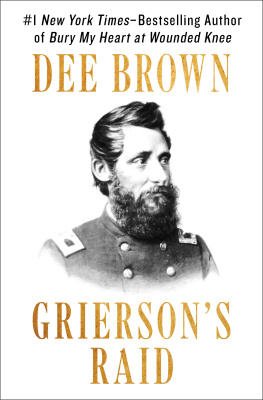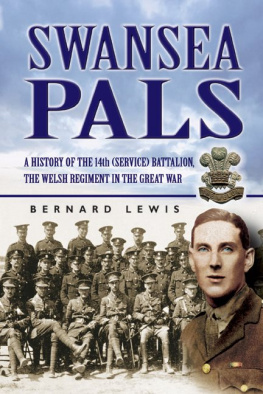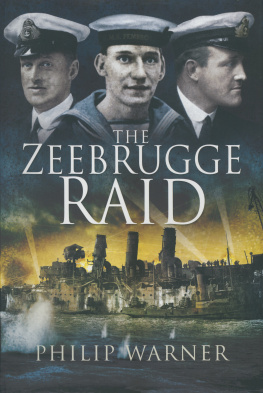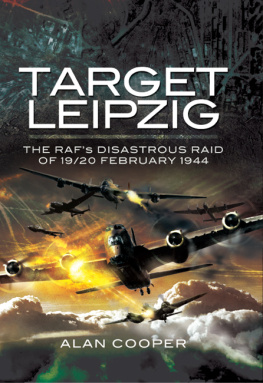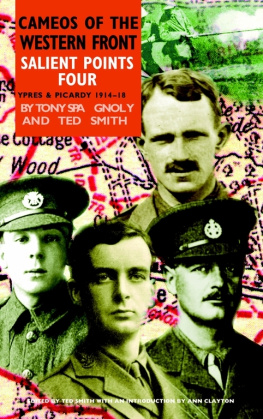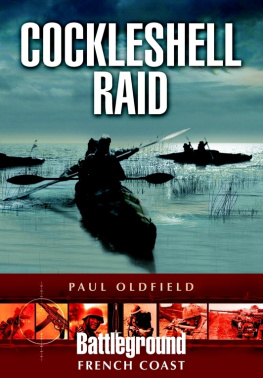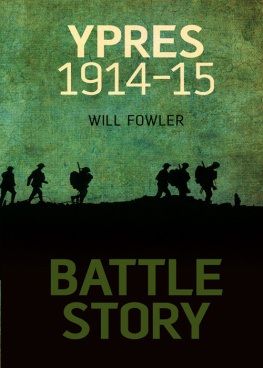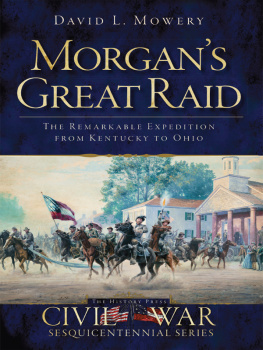The Cameos of the Western Front series of books
By the same authors:
Salient Points One
Cameos of the Western Front
Ypres Sector 191418
Salient Points Two
Cameos of the Western Front
Ypres Sector 191418
A Walk Round Plugstreet
South Ypres Sector 191418
First published in 1991 by MultiDream Publications.
Revised edition 1998
Published by LEO COOPER
an imprint of
Pen & Sword Books Limited
47, Church Street Barnsley, South Yorkshire S70 2AS
Copyright Tony Spagnoly and Ted Smith 1998
Introduction Copyright John Laffin
Maps IMCC Ltd.
Front Cover design by Jim Ludden/Ted Smith
A CIP catalogue record for this book is available
from the British Library
ISBN 085052 649 3
Typeset by IMCC Ltd. in 11/12 point Garamond Light
In compiling this very modest appreciation of the Australian effort at Ypres during October 1917, I will admit to approaching it in a spirit of remembrance and respect to those young men who travelled half a world to fall in Flanders.
I do owe a debt to many friends and organisations and this is comprehensively acknowledged with thanks. To the staff of the Imperial War Museum, Lambeth, London, the Public Records Office, Kew, London and the Commonwealth War Graves Commission, Maidenhead, Berkshire, a special thanks for the courtesy and assistance extended when consulting the various written records, photographs, references and maps held amongst their archived materials.
Bob Butcher, Hon. Editor of Stand To, the official journal of the Western Front Association was most encouraging and kindly included my initial article on the Celtic Wood raid in one of its editions. Several delightful ladies were always smilingly available with the typewriter when first drafts were needed and to Joan Schlewinski from Orpington and Sally Buchan from Oxford I hereby record my grateful thanks. A further debt is owed to my very good friends, Tony Shepherd from Oxford and Tom Gudemestad from Seattle, USA, who have tramped with me many times around the Broodseinde Ridge, deep in debate and discussion about those traumatic days in 1917.
Tony also found the time and made the effort to visit the town of Gawler in Southern Australia to photograph the war memorial and the chapel within which Lieutenant Scott, the commander of the raiding party on Celtic Wood, and others of the 10th Battalion A.I.F. are honoured. In Gawler he was fortunate enough to make contact with Sergeant Tony Traeger of the Gawler police force who dedicated much of his time to helping with the research on Lieutenant Scott and whose contribution did much to help finalise the work on this book. He, assisted by Mr and Mrs Lawrie Ronan of the Gawler Institute, supplied the print of a portrait in honour of her fallen sons which has hung in the Institute from the early post-war years. John Dray from Devon and Vic Sayer from Whitstable gave me the support and friendly counsel needed to establish the correct military assumptions, and this I gladly accepted from men who had experienced war at the sharp end in Italy and north-west Europe during the 19391945 conflict. I must not forget the young and talented Mary Freeman from Marlborough for her expert help and advice on the poem The Broodseinde Ridge appearing in this book, and I must give thanks to her mother, Pat Freeman, whose contribution of her emotive poem Ypres, November 11th, 11a.m. adds to the content of these pages. Gratitude is extended to Mrs Peggy Crowley who kindly gave permission to reproduce the photograph and detailed events leading to the award of the D.C.M. to her late father Sergeant Harry Combes, R.G.A.
I am very much aware of the unstinting advice and knowledge afforded to me by two of our leading historians, John Laffin and John Terraine. Their standing in the field of military writing today is known by anyone remotely interested in the subject, and as well known are their respective positions on the question of the High Commands conduct of the war. Be that as it may, both have been free with their considered comment and support, and my deep thanks and respect go to them both. I also owe a great debt to the late John Giles the founder of The Western Front Association which he formed to perpetuate the memory of all those who fell during the Great War. He has been helpful and supportive, and it was his very successful books on Ypres and the Somme which provided the impetus I needed to complete this project on Celtic Wood.
Jim Ludden has brought his creative talent to bear in the design of the book jacket and David Cohen was always ready and willing to advise and contribute on illustrative and art content. Lastly, thanks must go to Corinne Smith, who, as well as caring for home and family and working at a full-time job, somehow managed to help Ted with his research, spent hours with him and myself tramping the battle area and, at the same time, cared for three young children, all experienced battlefield visitors. Corinne arranged and helped with the proof-reading of the book and generally supported Ted throughout the project!
On reflection though, I can see that the unifying influence and common thread was the Australian soldier, the Digger himself. His bravery, his expertise and, not least, his singular humour - a magical combination!
A. F. Spagnoly. August 1990 London
One of the definitive accounts of the great battles for the Passchendaele Ridge, which raged around the Belgian town of Ypres for the latter part of 1917, was written in 1959 by an American historian. He used some very telling word pictures of the pain and suffering, describing scenes which he said would haunt Western civilisation for generations. For the 9th October 1917, he details a major corps attack by British and Australian infantry across the devastated and waterlogged battlefield from the Gravenstafel ridge upward towards the village of Passchendaele itself. This attack, carried out in an heroic fashion by all who took part, was not a success, due in the main part to a stern German defence system and quite hopeless conditions underfoot. Even to emerge from their muddy trenches and to launch themselves forward, under a withering hostile fire, in horrendous weather, was to the eternal credit of the attacking troops, especially when considering that this would be for many of them the first time in action.
As if this level of bloodletting was not enough, the planners threw in less than one hundred young Australians, slightly to the south of Broodseinde, in an attempt to convince the Germans to spread their counter-battery barrage away from the area of the main advance. This was to be a raid in strength on a small woodland known as Celtic Wood, a well fortified area just south-east of the notorious Broodseinde Crossroads. This raid was referred to briefly in the book and was covered within three to four lines.



